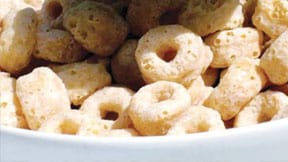Always consult your metabolic healthcare professional before introducing new foods or making any changes to your child’s diet.
Introducing solids is an exciting time in your baby’s development, but it may come with some anxiety for you. That’s completely normal! The American Academy of Pediatrics (AAP) currently recommends gradually introducing solid foods when a baby is about 6 months old, as well as showing other signs of readiness.1
How will you know when your baby is ready to start eating solid foods? We compiled a list of questions to ask yourself that may help you understand whether your baby is showing signs of readiness.1 Remember, always check with your metabolic dietitian before making any changes to your baby’s diet.
Can my baby support his/her own head?
To eat solid food, babies need good head and neck control and should be able to sit up unassisted in a highchair.
Does my baby open their mouth when offered a spoon? Are they able to move the food from the spoon into their mouth?
When babies are very young, they have a reflex to thrust their tongue out if foreign objects get in their mouths. This reflex helps babies not to choke on foreign objects they put in their mouths. Around 4-6 months, this reflex relaxes, allowing babies to move food into their mouths, rather than pushing it out immediately with their tongue. A baby who opens wide for a spoon and accepts the food into their mouth is showing signs of readiness.
Is my baby interested in food?
A baby that stares at food, smacking their lips or reaching for it, may be signaling that they are ready to try some new things!

What types of food should I offer?
Talk to your metabolic dietitian about which foods are best for your baby. Your dietitian may have you start by offering low protein vegetables, fruits, or baby cereal. Ready-to-eat first foods are available at the grocery store. Some parents make their own baby food at home. If you decide to make homemade baby food, be sure to follow proper food safety measures during preparation and storage. Only offer one new food at a time. Wait 3-5 days before introducing new foods so you can easily monitor any possible signs of food allergy or intolerance.

How much should I give my baby?
At first, only offer small amounts (about 1-2 teaspoons at a single meal). Gradually more food can be offered. Remember, your baby is learning how to eat for the very first time, so they may not eat much at first. That’s okay! With every exposure to foods, your baby will become more comfortable. Once your baby is eating more at a single meal (2-3 tablespoons), you can start giving solid foods at a second meal in the day and then at a third.
Suitable Low Protein Baby Foods2,3
Remember, always consult your metabolic dietitian before introducing new foods or making any changes to your child’s diet.
Very First Foods (Around 6 Months Old)
- Thin vegetable purees, like carrots, squash, and green beans
- Thin fruit purees, like pears, peaches and prunes
- Infant cereal* mixed with metabolic or standard infant formula or breast milk
Thicker Purees and Soft, Diced Foods (8-10 Months Old)
- Soft cooked vegetables like carrots, squash, and green beans
- Soft diced or smashed fruit, like bananas, peaches, and melon
- Baby puffs and some cereals*
- Dairy-free unsweetened coconut milk yogurt alternative*

Finger Foods & New Textures (10-12 Months Old)
- Diced raw fruits and soft vegetables with skin & seeds removed, such as apples, berries, or cucumbers
- Cooked vegetables, diced or cut into strips such as zucchini, bell pepper, or cauliflower
- Toast made from low protein bread
- Low protein cereals and soft cooked low protein pasta
*Limited amounts only; be sure to discuss PHE- or protein-counting and your child’s daily allowance with your metabolic dietitian prior to providing any new foods.
References:
- https://www.healthychildren.org/English/ages-stages/baby/feeding-nutrition/Pages/Starting-Solid-Foods.aspx. Accessed Oct 22, 2020.
- https://www.npkua.org/What-is-PKU/My-PKU-Binder. Accessed Oct 22, 2020.
- Bernstein L, Freehauf C. Eat Right Stay Bright™ Guide for Hyperphenylalaninemia. Children’s Hospital Colorado. Chapter 1; pages 51-58.
